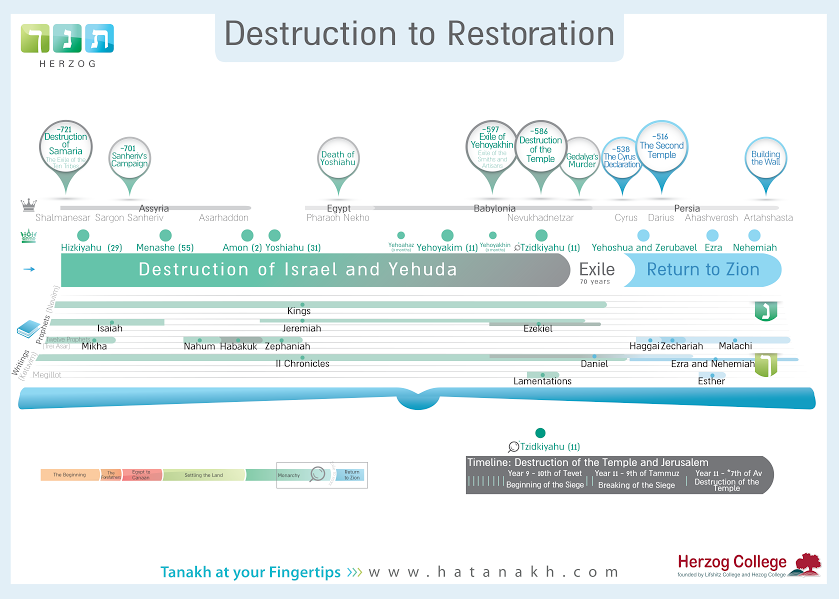Destruction to Restoration - Chart and Explanation
Biblical Events appear in the top of the chart. Each historical event is color – coordinated according to the respective historical time period. These events significantly influenced the fates of the Kingdoms of Yehuda and Israel, as well as the fate of the Returnees to Zion. Gregorian calendar dates are provided for major events in order to streamline the process of locating these events within a broader historical context. Events with primary significance are enlarged.
Empires and Foreign Kings are displayed in the second line, in correlation with the events above. These empires instigated the central events in Israel, Yehuda, and the neighboring nations. Four empires ruled over the area over the course of 300 years: Assyria destroyed the Kingdom of Israel and severely weakened Yehuda, which was portrayed by the prophet as God's will and retribution: "O Assyria, the rod of My anger, the staff in their hands is my indignation!" (Is. 10:5). Jeremiah criticizes the dependence of the kings of Yehuda on foreign empires: "And now what have you in the way to Egypt, to drink the waters of Shihor? And what have you in the way of Assyria, to drink the waters of the River?" (Jer. 2:18). King Nevukhadnetzar of Babylonia destroyed the Temple in Jerusalem and exiled those who remained in Yehuda. King Cyrus of Persia, the ruler of the last major empire in the biblical era, dramatically reversed the aggressive policy enacted by his predecessors, and permitted the Israelites to return to their land and rebuild the Temple, an action which awarded him the title "God's anointed one" (Is. 45:1).
The Kings and Leaders of Yehuda often played active roles in the international arena, maintaining alliances and fighting the ruling empires. Hizkiyahu and Yoshiyahu stand out in particular for their political and religious revolutions. Following the significant weakening of the kingdom of Yehuda in the years leading toward destruction, the kings of Yehuda were appointed by foreign kings (Yehoyakim by the Egyptians; Tzidkiyahu by the Babylonians). Prophets of those times would discuss the political, religious, and social leadership of these kings as a central topic in many prophetic speeches. At the time of the Return to Zion, the leaders of Yehuda were given autonomy by the Persian Empire.
The Storyline is presented in the central axis of the diagram, entitled "Destruction to Restoration." The storyline describing the downfall of Israel begins with the destruction of Israel (the Northern Kingdom) and ends with the destruction of Yehuda (the Southern Kingdom). Periods are color-coded to convey the transition: Green turns to gray, signifying the loss of sovereignty in the two kingdoms, ultimately leading to destruction and exile; turquoise expresses the hope and desire to rebuild that which was destroyed. In the era of the Return to Zion, social and political difficulties experienced by those who had returned, as well as the reality that many Jews opted not to return to Israel, led to a sense of disappointment among some of the returnees. Seventy years of exile separate the destruction of the Temple and the Return to Zion (the destruction of the First Temple was in -586, while the construction of the Second Temple began in -516). This period is mentioned in Jeremiah (25:12) and Ezra (1:1).
The bottom of the diagram includes a detailed description of the final two years of the First Temple during Tzidkiyahu's reign, from the siege on Jerusalem to the destruction of the Temple and Jerusalem (7th of Av based on II Kings 25:8 and the 10th of Av based on Jeremiah 52:12).
Biblical Books – Prophets and Scriptures
The center of the diagram lists books that relate to this period of exile and return. The numerous books reflect the difficulties and complex prophetic challenges of the time.
II Kings and II Chronicles describe this era in a complete and consecutive manner. Both books end on a positive and optimistic note long after the destruction: II Kings ends with the rise of Yehoyakhin from prison to honorable stature in the Babylonian court, and II Chronicles ends with the Cyrus Declaration.
Please see the attached file for a printable version of the explanation.


